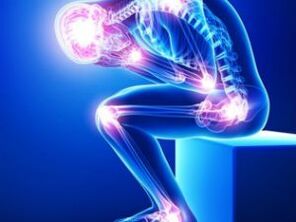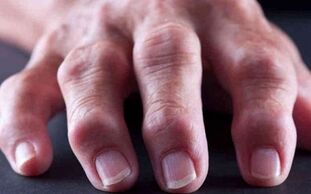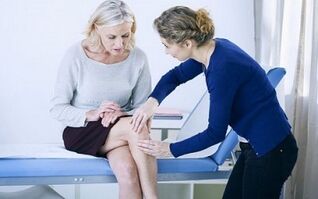
Joint problems often occur locally when a person experiences pain in a particular joint and can determine the location of the pain. But sometimes joint pain can not be localized, because all joints or several at the same time hurt. Talking about rheumatoid arthritis in this case is premature, because, in addition to this pathology, there are other diseases in which the pain covers all the joints of the musculoskeletal system.
A caring doctor who will analyze patient complaints and identify cause-and-effect relationships can identify the reasons why all joints are sore at the same time. Determining a diagnosis is far from that easy, and with the most common symptoms, it is not possible to choose a specific pathology immediately, after undergoing several examinations. Therefore, if systemic joint pain occurs, do not delay a visit to the doctor.
If all the joints of the musculoskeletal system are severely ill, there may be the following reasons:
- Pathology of autoimmune origin and systemic allergic reactions.
- Rheumatoid arthritis.
- Osteoarthritis.
- Chronic fatigue, increased physical activity.
- Body poisoning.
- Blood diseases.
When pain appears in some or all of the joints, one must immediately remember that such a condition is only a reaction to a particular disease, but not an independent disease. The only exceptions are pathologies such as osteoarthritis and rheumatoid arthritis, when the cause is damage to the cartilage itself.
Rheumatoid Arthritis
This disease refers to a chronic autoimmune pathology in which joints throughout the body are affected. A hallmark of rheumatoid arthritis is the involvement of many joints in pathological processes.
At the same time, cytokines, metalloproteinase and chemotactic cytokines play an important role in the inflammatory process. These are the anti-inflammatory elements that activate the activity of the human body's own immune cells. As a result, they move to the site of inflammation, the joints of the human body, and provoke a special inflammatory response.
The special manifestations of rheumatoid arthritis are damage to the peripheral joints, and symmetry. As the disease worsens, the pathology affects the larger joints. Pathology affects mainly women, in men it occurs three times less often. It is diagnosed between the ages of thirty and fifty, but sometimes it can also appear in adolescents - the disease is called juvenile arthritis.
Although scientists have explained the immune nature of the disease, it is still not possible to determine the exact cause of rheumatoid arthritis - why anti-inflammatory cells acquire such pathological activity. To date, genetic predisposition to rheumatoid arthritis has been proven, and this also indicates that negative factors such as tobacco smoking, transmission of viral diseases, etc. , influence the appearance of pathology.
The course of the disease is due to the activation of the immune complex, which is produced by the synovial membrane and is present in the blood vessels. The rapid reaction to them is a rheumatoid factor - antibodies produced to this complex. And in some cases, they appear on their own, without provoking factors.
HELP!In the early stages of pathological development, macrophages move to the affected area, after a few seconds the number of lymphocytes increases there. Release of inflammatory mediators and provoke the development of pathological processes throughout the body.
In the event of a chronic lesion of the synovium, instead of its normal thickness it becomes denser and coarser, growing and folding in the form of a villi formed on its surface. Synovial fluid cells produce stromelysin and collagenase, which induce destructive processes in cartilage tissue. The inflammatory process is enhanced with the production of prostaglandins, fibrin deposits and necrotic processes appearing.
Excessive synovial tissue provokes inflammatory mediators that contribute to the destruction of not only cartilage, but also bone tissue, ligaments and joint capsules. In the joint fluid itself, the number of leukocytes increases.
The small joints of the body are covered with special rheumatoid nodules, when the joints change shape and become ugly in appearance. The content of these rheumatoid nodules is the necrotic part of macrophages, fibroblasts and plasma cells. Similar nodules can be found in internal organs.
The disease develops gradually. Patients suffer from general and local articular manifestations - there is characteristic stiffness in the joints in the morning, fatigue is observed, appetite is lost, body temperature rises to subfebrile. The condition of the joints improved about an hour after waking up. The joints are affected symmetrically and usually rheumatoid arthritis affects the following joints:
- Wrist.
- Metacarpophalangeal second and third.
- Shoulders.
- Knee.
- Ankle.
- Hips.
- Elbow.
In fact, the disease threatens any joint of the musculoskeletal system. The distal phalangeal joint, as well as the axial skeletal elements, are most rarely involved.

The joints remain sore, swollen and reddened, and become hot when touched. To reduce the painful sensation, patients try to bend their joints - this way they feel pain. The development of the disease occurs in the first 5-6 years after the onset of the first pathological changes. And already ten years after the development of the pathology, irreversible changes appear in the patient.
During this time, patients experience significant joint deformities, and instability may occur. When the nerve branch is pressed, the patient suffers from carpal syndrome, and with rheumatoid arthritis of the knee joint, the patient is threatened with Baker cysts, deep vein thrombosis, and so on.
In parallel with articular changes, external articular body manifestations are observed, which develop with pathological development in every third patient. Examples of such manifestations are rheumatoid nodules in the lungs, vasculitis, Felty syndrome, myocarditis.
Diagnosing a disease is not so difficult. Special clinical criteria for rheumatoid arthritis are shown in the blood, increased erythrocyte sedimentation rate, C-reactive protein and rheumatoid factor are found in large numbers.
The patient's health condition is determined by X-ray pictures, performed when rheumatoid arthritis is suspected. The disease is distinguished from osteoarthritis, sarcoidosis, psoriatic arthritis and ankylosing spondylitis, arthritis develops against the background of hepatitis C.
IMPORTANT!When making a diagnosis, it should be noted that the disease has a relatively high mortality, but in rheumatoid arthritis it is not associated with joint damage, but with pathological changes in the heart, internal bleeding.
Treatment of this disease is carried out with supportive therapy, as well as strong NSAIDs. It is best to provide adequate load on the joints, add exercise therapy. If necessary, surgery is performed.
Osteoarthritis
Osteoarthritis is another common pathology that can affect large and small joints. Various factors can provoke osteoarthritis, which, first of all, has a negative effect on joint cartilage tissue. The cartilage throughout the human body performs several functions and is primarily a shock absorber in the process of various movements. Persistent stress causes increased wear on cartilage.
If a person with good health and strong immunity has a chance to recover damaged tissue, then in elderly patients, as well as in patients with increased pressure on the joints, new fiber synthesis is almost non-existent, and cartilage tissue does notrestored. Traditionally, osteoarthritis was considered the result of mechanical action on tissues, but now doctors consider previously transmitted inflammatory diseases as a factor in the development of systemic osteoarthritis.
A typical symptom of this disease is pain in all joints, as the matrix loses very important nutrients - glucosamine and chondroitin sulfate. Deficiency of these elements leads to so-called joint dislocations, i. e. cracks of various depths appear in the cartilage tissue.
The inflammatory process can also interfere with the normal structure of cartilage tissue, therefore, when localized in the subcondral part of the bone, doctors often diagnose microfracture in patients. The bone marrow in the joint is covered with growth - osteophytes. They serve to compensate for the worn cartilage, but in reality they bring a more negative sensation to the patient.

Menopausal women are most prone to osteoarthritis.
Since the exact cause of osteoarthritis has not been explained, doctors have identified several factors that contribute to the development of the disease:
- Congenital deficiency of cartilage tissue, where it is very vulnerable to injury. For example, patients with such pathology suffer from flat feet, and dislocations are often diagnosed - complete and incomplete.
- Gender is also one of the factors in the development of this disease, because according to statistics, osteoarthritis is twice as common in women than men.
- Age characteristics - the disease usually develops in patients over forty-five years of age, in women coinciding with menopause.
- Obesity.
- Metabolic problems.
- Increased athlete load on the joints.
- Traumatic joint injury.
The disease develops in any joint, but usually the starting joint is the one with the greatest physical activity. It can be localized to the knee joints, hips, elbows, and so on.
The symptomatology of this disease is very clear, so osteoarthritis is not to be missed. In a person, with increasing load, the joint immediately begins to ache, while the intensity of the discomfort can vary: from slight whining in the joint to the strongest sharp pain in the joint. During movement, the pain increases, and when resting, it becomes less pronounced.
In parallel with the pain, the patient experiences a crack in the joint, the appearance of stiffness. The patient has limited mobility. Especially at the time of disease progression, when reflex muscle spasms are added to the pathology.
In the later stages of the development of the disease, the patient experiences a special joint blockage - this is a sharp pain when the joint suddenly stops moving due to the appearance of severe pain in the joint. This is due to the entry of fragments of cartilage tissue into the cavity, restricting movement. If the disease is accompanied by inflammation, then there is swelling of the synovial membrane, which is easily seen.
The development of osteoarthritis is quite individual. In some patients, X-rays show signs of pathological development, but according to the sensation, the picture of the disease does not change. At the same time, other patients feel severe pain, inflammation and limited movement, when the joint itself in the picture looks satisfactory, corresponding to the degree of pathological development.
Diagnosis of the disease is based on X-ray data and clinical signs of the disease. In parallel, you can do an ultrasound scan or magnetic resonance imaging if there is a need to assess the presence of complications.
Doctors try to treat this disease by taking into account the maintenance of maximum mobility in the joints and the patient's ability to work in the profession. Therefore, in therapy, it is very important to stop the progression of the disease, relieve pain in the joints and relieve inflammation.
Currently, the possibilities for treating osteoarthritis are limitless and treatment tactics are difficult to identify as successful, as the joints are irreversible. The disease enters a chronic stage and you should always fight it.
TIPS!Even so, the dissatisfied prognosis does not cause the patient to have a disability - with successful therapy, you can learn to live with osteoarthritis and even maintain physical activity.
For treatment, doctors use the following groups of funds:
- Nonsteroidal anti-inflammatory drugs.
- Glucocorticosteroids.
- Chondroprotectors.
- Means to activate blood circulation.
- Relax the muscles.
The therapy of this disease consists mainly of drugs that can maximally restore cartilage tissue and create metabolic processes in the joints. Therefore, the main emphasis is on chondroprotectors, its use begins immediately after the elimination of inflammation. Treatment with chondroprotectors is long-term and the best results appear only with timely treatment.
Other diseases
Rheumatoid arthritis and osteoarthritis are the most common pathologies in which joint pain and soreness throughout the body. But, in addition to morbidity leaders, there are other conditions that cause pain in the articular joints.

Joint pain can be a manifestation of leukemia.
Joint pain can be a manifestation of blood disorders. The pathology of hematology today is the most difficult not only in the diagnosis for attending physicians, but also in therapy. Often it is accompanied by oncological factors and the disease acquires a completely different meaning for the patient. Usually joints throughout the body are sick with leukemia - acute and chronic. At the same time, patients do not even suspect its meaning, as blood test results do not indicate abnormalities.
Arthralgia is not isolated, not only the affected articular elements, but also bones and muscles. Therefore, doctors advise patients with long-term painful sensations, it is important to consult not only with an orthopedic traumatologist or surgeon, but also a hematologist who may suspect pathology and send the patient for additional research.
Drunkenness in the body is another cause of joint pain. The fact is that the joints respond very sharply to the intake of toxins into the body, and if the joints begin to ache and twist, then the influence of occupational hazards, intoxication with household waste, tobacco smoking and alcoholism can be blamed. The patient experiences very unpleasant symptoms - all joints are sore, as if with the flu, the general condition of the body suffers.
Improving the patient's health is possible after diagnosis. Detoxification therapy is performed, the blood is purified, and, consequently, the joint fluid from toxins.
Most Important
Pain in all joints of the body is not always associated with the pathology of the joint itself. If the joints of the body are affected, usually rheumatoid arthritis or osteoarthritis is the cause. Symptoms increase rapidly, and pathological processes in the joints occur.
In other cases, when joint pain is not related to damage to the joint, discomfort can be a manifestation of systemic diseases, for example, blood leukemia, as well as osteoporosis, intoxication, infection. Overcoming the disease is not so easy, but it is more difficult to diagnose the disease. Patients with joint pain should contact the clinic in a timely manner to begin treatment at an early stage.

























